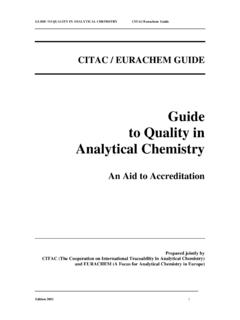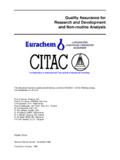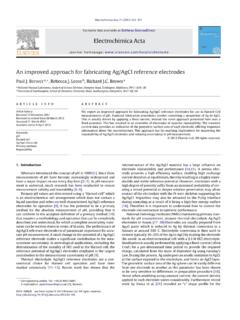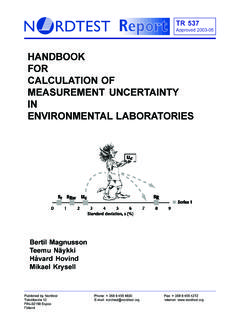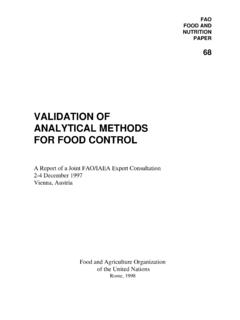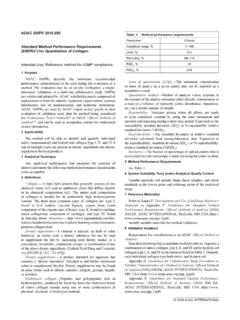Transcription of Quantifying Uncertainty in Analytical Measurement - CITAC
1 EURACHEM / CITAC Guide CG 4 Quantifying Uncertainty inAnalytical MeasurementSecond Guide* Quantifying Uncertainty inAnalytical MeasurementSecond EditionEditorsS L R Ellison (LGC, UK)M Rosslein (EMPA, Switzerland)A Williams (UK)Composition of the Working GroupEURACHEM membersA Williams ChairmanUKS EllisonSecretaryLGC, Teddington, UKM BerglundInstitute for Reference Materials andMeasurements, BelgiumW HaesselbarthBundesanstalt fur Materialforschung undPrufung, GermanyK HedegaardEUROM IIR KaarlsNetherlands Measurement Institute, TheNetherlandsM M nssonSP Swedish National Testing and ResearchInstitute, SwedenM R ssleinEMPA St. Gallen, SwitzerlandR StephanyNational Institute of Public Health and theEnvironment, The NetherlandsA van der VeenNetherlands Measurement Institute, TheNetherlandsW WegscheiderUniversity of Mining and Metallurgy, Leoben,AustriaH van de WielNational Institute of Public Health and theEnvironment, The NetherlandsR WoodFood Standards Agency, UKCITAC MembersPan Xiu RongDirector, NRCCRM.
2 ChinaM SalitNational Institute of Science and TechnologyUSAA SquirrellNATA, AustraliaK YasudaHitachi Ltd, JapanAOAC RepresentativesR JohnsonAgricultural Analytical Services, Texas StateChemist, USAJung-Keun WashingtonD MowreyEli Lilly & Co., Greenfield, USAIAEA RepresentativesP De ReggeIAEA ViennaA FajgeljIAEA ViennaEA RepresentativeD Galsworthy,UKAS, UKAcknowledgementsThis document has been produced primarily by a jointEURACHEM/ CITAC Working Group with thecomposition shown (right). The editors are grateful toall these individuals and organisations and to otherswho have contributed comments, advice of this Guide was in part supported undercontract with the UK Department of Trade andIndustry as part of the National Measurement SystemValid Analytical Measurement (VAM) Programme.* CITAC ReferenceThis Guide constitutes CITAC Guide number 4 Quantifying Uncertainty in Analytical MeasurementEnglish editionSecond edition 2000 ISBN 0 948926 15 5 Copyright 2000 Copyright in this document is vested in thecontributing members of the working iCONTENTSFOREWORD TO THE SECOND EDITION11.
3 SCOPE AND FIELD OF APPLICATION32. DEFINITION OF Uncertainty Uncertainty ERROR AND UNCERTAINTY53. Analytical Measurement AND METHOD CONDUCT OF EXPERIMENTAL STUDIES OF METHOD TRACEABILITY94. THE PROCESS OF Measurement Uncertainty ESTIMATION115. STEP 1. SPECIFICATION OF THE MEASURAND136. STEP 2. IDENTIFYING Uncertainty SOURCES147. STEP 3. Quantifying Uncertainty EVALUATION RELEVANCE OF PRIOR EVALUATING Uncertainty BY QUANTIFICATION OF INDIVIDUAL CLOSELY MATCHED CERTIFIED REFERENCE USING PRIOR COLLABORATIVE METHOD DEVELOPMENT AND VALIDATION STUDY USING IN-HOUSE DEVELOPMENT AND VALIDATION EVALUATION OF Uncertainty FOR EMPIRICAL EVALUATION OF Uncertainty FOR AD-HOC QUANTIFICATION OF INDIVIDUAL EXPERIMENTAL ESTIMATION OF INDIVIDUAL Uncertainty ESTIMATION BASED ON OTHER RESULTS OR MODELLING FROM THEORETICAL ESTIMATION BASED ON SIGNIFICANCE OF BIAS248.
4 STEP 4. CALCULATING THE COMBINED STANDARD COMBINED STANDARD EXPANDED UNCERTAINTY27 Quantifying ii9. REPORTING INFORMATION REPORTING STANDARD REPORTING EXPANDED NUMERICAL EXPRESSION OF COMPLIANCE AGAINST LIMITS30 APPENDIX A. EXAMPLES32 INTRODUCTION32 EXAMPLE A1: PREPARATION OF A CALIBRATION STANDARD34 EXAMPLE A2: STANDARDISING A SODIUM HYDROXIDE SOLUTION40 EXAMPLE A3: AN ACID/BASE TITRATION50 EXAMPLE A4: Uncertainty ESTIMATION FROM IN-HOUSE VALIDATION OF ORGANOPHOSPHORUS PESTICIDES IN A5: DETERMINATION OF CADMIUM RELEASE FROM CERAMIC WARE BYATOMIC ABSORPTION SPECTROMETRY70 EXAMPLE A6: THE DETERMINATION OF CRUDE FIBRE IN ANIMAL FEEDING STUFFS79 EXAMPLE A7: DETERMINATION OF THE AMOUNT OF LEAD IN WATER USING DOUBLEISOTOPE DILUTION AND INDUCTIVELY COUPLED PLASMA MASS SPECTROMETRY87 APPENDIX B. DEFINITIONS95 APPENDIX C. UNCERTAINTIES IN Analytical PROCESSES99 APPENDIX D.
5 ANALYSING Uncertainty OF AND EFFECT E. USEFUL STATISTICAL METHOD FOR Uncertainty FROM LINEAR LEAST SQUARES : DOCUMENTING Uncertainty DEPENDENT ON ANALYTE LEVEL108 APPENDIX F. Measurement Uncertainty AT THE LIMIT OF DETECTION/LIMIT OF AND RESULTS AND COMPLIANCE STATEMENTS113 APPENDIX G. COMMON SOURCES AND VALUES OF UNCERTAINTY114 APPENDIX H. BIBLIOGRAPHY120 Quantifying 1 Foreword to the Second EditionMany important decisions are based on the results of chemical quantitative analysis; the results are used, forexample, to estimate yields, to check materials against specifications or statutory limits, or to estimatemonetary value. Whenever decisions are based on Analytical results, it is important to have some indicationof the quality of the results, that is, the extent to which they can be relied on for the purpose in hand. Usersof the results of chemical analysis, particularly in those areas concerned with international trade, are comingunder increasing pressure to eliminate the replication of effort frequently expended in obtaining in data obtained outside the user s own organisation is a prerequisite to meeting this some sectors of Analytical chemistry it is now a formal (frequently legislative) requirement forlaboratories to introduce quality assurance measures to ensure that they are capable of and are providingdata of the required quality.
6 Such measures include: the use of validated methods of analysis; the use ofdefined internal quality control procedures; participation in proficiency testing schemes; accreditation basedon ISO 17025 [ ], and establishing traceability of the results of the measurementsIn Analytical chemistry, there has been great emphasis on the precision of results obtained using a specifiedmethod, rather than on their traceability to a defined standard or SI unit. This has led the use of officialmethods to fulfil legislative and trading requirements. However as there is now a formal requirement toestablish the confidence of results it is essential that a Measurement result is traceable to a defined referencesuch as a SI unit, reference material or, where applicable, a defined or empirical (sec. ) method. Internalquality control procedures, proficiency testing and accreditation can be an aid in establishing evidence oftraceability to a given a consequence of these requirements, chemists are, for their part, coming under increasing pressure todemonstrate the quality of their results, and in particular to demonstrate their fitness for purpose by giving ameasure of the confidence that can be placed on the result.
7 This is expected to include the degree to which aresult would be expected to agree with other results, normally irrespective of the Analytical methods useful measure of this is Measurement the concept of Measurement Uncertainty has been recognised by chemists for many years, it wasthe publication in 1993 of the Guide to the Expression of Uncertainty in Measurement [ ] by ISO incollaboration with BIPM, IEC, IFCC, IUPAC, IUPAP and OIML, which formally established general rulesfor evaluating and expressing Uncertainty in Measurement across a broad spectrum of measurements. ThisEURACHEM document shows how the concepts in the ISO Guide may be applied in chemicalmeasurement. It first introduces the concept of Uncertainty and the distinction between Uncertainty anderror. This is followed by a description of the steps involved in the evaluation of Uncertainty with theprocesses illustrated by worked examples in Appendix evaluation of Uncertainty requires the analyst to look closely at all the possible sources of , although a detailed study of this kind may require a considerable effort, it is essential that theeffort expended should not be disproportionate.
8 In practice a preliminary study will quickly identify themost significant sources of Uncertainty and, as the examples show, the value obtained for the combineduncertainty is almost entirely controlled by the major contributions. A good estimate of Uncertainty can bemade by concentrating effort on the largest contributions. Further, once evaluated for a given methodapplied in a particular laboratory ( a particular Measurement procedure), the Uncertainty estimateobtained may be reliably applied to subsequent results obtained by the method in the same laboratory,provided that this is justified by the relevant quality control data. No further effort should be necessaryunless the procedure itself or the equipment used is changed, in which case the Uncertainty estimate wouldbe reviewed as part of the normal first edition of the EURACHEM Guide for Quantifying Uncertainty in Analytical Measurement [ ]was published in 1995 based on the ISO UncertaintyForeword to the Second 2 This second edition of the EURACHEM Guide has been prepared in the light of practical experience ofuncertainty estimation in chemistry laboratories and the even greater awareness of the need to introduceformal quality assurance procedures by laboratories.
9 The second edition stresses that the proceduresintroduced by a laboratory to estimate its Measurement Uncertainty should be integrated with existingquality assurance measures, since these measures frequently provide much of the information required toevaluate the Measurement Uncertainty . The guide therefore provides explicitly for the use of validation andrelated data in the construction of Uncertainty estimates in full compliance with formal ISO Guideprinciples. The approach is also consistent with the requirements of ISO 17025:1999 [ ]NOTEW orked examples are given in Appendix A. A numbered list of definitions is given at Appendix B. Theconvention is adopted of printing defined terms in bold face upon their first occurrence in the text, with areference to Appendix B enclosed in square brackets. The definitions are, in the main, taken from theInternational vocabulary of basic and general standard terms in Metrology (VIM) [ ], the Guide [ ] andISO 3534 (Statistics - Vocabulary and symbols) [ ].
10 Appendix C shows, in general terms, the overallstructure of a chemical analysis leading to a Measurement result. Appendix D describes a general procedurewhich can be used to identify Uncertainty components and plan further experiments as required; Appendix Edescribes some statistical operations used in Uncertainty estimation in Analytical chemistry. Appendix Fdiscusses Measurement Uncertainty near detection limits. Appendix G lists many common Uncertainty sourcesand methods of estimating the value of the uncertainties. A bibliography is provided at Appendix UncertaintyScope and Field of 31. Scope and Field of Guide gives detailed guidance for the evaluation and expression of Uncertainty in quantitativechemical analysis, based on the approach taken in the ISO Guide to the Expression of Uncertainty inMeasurement [ ].

